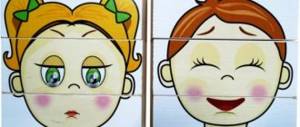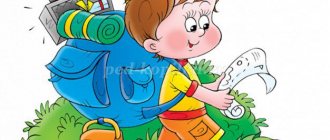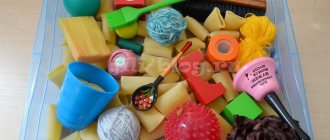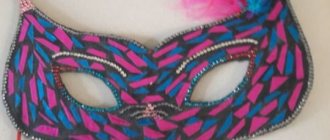Using mind cards in preschool educational institutions
Elena Tataurova
Using mind cards in preschool educational institutions
Municipal autonomous preschool educational institution kindergarten "Chaika"
Nizhneturinsky urban district
USING INTELLIGENCE CARDS IN DOW
MASTER CLASS
Developed by: teacher E. A. Tataurova
first qualification category
Dear colleagues, from my material you can learn what a mind map is, what a mind map looks like, the properties of a mind map, what it teaches and what it develops, as well as the rules for its construction.
I bring to your attention the presentation “Using mind maps in preschool educational institutions,” booklets, ready-made mind maps for the seasons for middle preschool children and a photo report on creating mind maps with my children.
The mind mapping method was created by the American scientist and businessman Tony Buzan. Translated, these are “mind maps.”
Mind maps came to the world of preschool technologies thanks to the candidate of pedagogical sciences V. M. Akimenko, who proposed using this method for the development of coherent speech in children.
A mind map is a unique and simple method of memorizing information, with the help of which both the creative and speech abilities of children develop and their thinking is activated.
Useful properties of mind maps are clarity, attractiveness and memorability.
Visibility - the identified problem with numerous sides is right in front of you, you can take it in at a glance.
Attractive - a good mind map has its own aesthetics; looking at it is not only interesting, but also pleasant. Tony Buzan recommended: “Get ready to create beautiful mind maps.”
Memorability lies in the fact that thanks to the work of both hemispheres of the brain, the use of images and colors, the mind map is easily remembered.
K. D. Ushinsky wrote: “Teach a child some five words unknown to him - he will suffer for a long time and in vain, but connect twenty such words with pictures, and he will learn on the fly.”
In teaching practice, mind maps can be used as follows:
way:
Direction 1 – Collection of material
Direction 2 – Consolidation and generalization of the material.
Direction 3 - Development of coherent speech. Composing stories
Master Class
General requirements for drawing up any intelligence map.
• Felt pens, colored pencils, markers, etc. are used to create maps.
• The sheet is positioned horizontally.
• The main idea is circled in the center of the page. To depict it, you can use drawings and pictures.
• For each key point, branches diverging from the center are drawn (in any direction). Each main branch has its own color.
• Only one keyword is written above each line-branch.
• You must write legibly in block capital letters.
• Each thought is circled, you can use drawings, pictures, associations about each word.
• Symbols and illustrations are added during the modeling process.
The sequence of work when drawing up a mind map to consolidate and generalize the material of the studied topic:
Option 1:
The theme is indicated (fruits, pets, flowers, etc.)
Children name noun words and depict things that relate to the topic.
Attribute words are selected for each noun.
Option 2:
— Attribute words and action words are selected for each noun.
Using the compiled mind map, children make sentences for any option.
In the modern world with a large flow of information, the use of mind maps in the direct educational activities of preschoolers gives enormous positive results. The use of mind maps allows for integration of areas.
We started making mind maps in the middle group. At first, these were maps that were small in content, reflecting one topic, and had in their structure only a classification in some areas. At the end of summer, the guys built quite complex intelligence cards, such as: all year round, pets.
Thanks to this work, children's associations develop, vocabulary is replenished and activated, the meaning of a word is formed, and fantasy develops. A child, working with mind maps, progresses in his development from simple logical operations: comparison, juxtaposition of objects, location in space, quantitative determination of common and integral parts to the ability to analyze, differentiate, and classify objects.
Of course, we plan to continue working with children in this direction.
Thank you for your attention!
Project on the topic: “INTELLIGENCE – MAP AS A TOOL FOR SPEECH DEVELOPMENT OF PRESCHOOL CHILDREN”
Municipal state preschool educational institution kindergarten
№ 22"Rowanushka"
Project on:
“INTELLIGENCE – MAP AS A MEANS OF SPEECH DEVELOPMENT OF PRESCHOOL CHILDREN”
Prepared by the teacher
Highest quarter categories
Boyarshina N.G.
Talitsa 2018
Innovative pedagogical technologies used in the context of the implementation of the Federal State Educational Standard for Education.
Project type
: long term
Project participants
: educators, pupils of the 5 - 7 year old group, parents.
Mind maps
: one of the methods for organizing the educational process with children of senior preschool age
Relevance
The introduction of the Federal State Educational Standard and the problems in teaching preschoolers emphasize the need to find new means, namely the use of various educational technologies and methods that help children achieve certain targets.
In pedagogical practice with preschool children, a sufficient number of technologies and techniques are used. But I believe that the most effective method for mastering knowledge is the Mind Map method by Tony Buzan - psychologist, author of the method of memorization, creativity and organization of thinking “mind map (memory), lecturer and consultant on intelligence issues.
Intelligence - cards
is a unique and simple method of memorizing information.
Due to its properties, the use of the Mind Maps method in working with children of senior preschool age will increase children’s interest in program content and make the process of assimilation of information more structured and visual. At the same time, it becomes possible to develop all mental processes, activate various analyzers, and the creative and intellectual potential of each child.
Target:
development of cognitive interest and cognitive abilities of children of senior preschool age through the introduction of the Intelligence Map method into the educational process.
Tasks:
- develop mental functions (attention, memory, thinking);
- stimulate speech activity, expand passive and active vocabulary, develop coherent speech, identify and compensate for those problems that create difficulties in the child’s speech development;
- develop children's interests, cognitive activity, curiosity;
- develop the child’s communication and interaction with adults and peers;
- to form elements of independence, purposefulness and self-regulation of one’s own actions;
- develop imagination and creativity;
- create continuity between kindergarten and school;
- develop fine motor skills of the hands;
- to form basic ideas about the norms and rules of a healthy lifestyle;
- develop the prerequisites for value-semantic perception and understanding of the natural world;
- promote the implementation of independent creative activity of children.
Properties of intelligence cards:
- clarity (in the intelligence map it is presented as much as possible: in the form of objects, objects, drawings and the order of actions with them);
- attractiveness (a good mind map has its own aesthetics; it is not only interesting to look at, but also pleasant. “Tune in to create beautiful maps” - T. Buzan);
- memorability (thanks to the work of both hemispheres of the brain, the use of images and colors, the mind map is easily remembered);
- timeliness (intelligence - the map helps to identify a lack of information);
- creativity (mind map stimulates creativity, helps to find non-standard ways to solve a problem);
- possibility of revision (revising the map after some time helps to assimilate the picture as a whole, remember information even better, and supplement it with new ideas).
Mapping methodology
Drawing up a memory map involves the use of various graphic tools (drawings, symbols, arrows, fonts).
1. It is preferable to place the sheet of paper horizontally: it is this arrangement that is most comfortable for depicting the radiant structure and this way more space is allocated for the drawing, which will allow it to be expanded and modernized.
2. The main idea (goal, subject, name of the new topic) is written (illustrated) and circled in the center.
3. From the “main idea”, using multi-colored highlighting, lines (branches) are drawn, each of which corresponds to a specific fragment of the topic under consideration.
4. Each branch is identified by a keyword or phrase.
5. The branches are detailed, symbols and illustrations are added.
The map can be as detailed as necessary to understand the topic.
Keywords are written in block letters, legibly; The font size is selected according to the importance of the given keyword. Intellectual maps should be abundantly supplied with various illustrations, which can be presented in the form of: model images, drawings by children, pictures cut out from magazines, newspapers, and their own symbols. Various arrows show connections between concepts.
Intelligence - map
when working with children, it is introduced gradually and this process is divided into 3 levels:
Stage 1.
Preparatory
Introducing children to intelligence maps (2nd half of the senior group).
At the beginning of work, children get the idea that any object or phenomenon can be told with “pictures”.
1 option
– first, the children compose a story according to the mind map created by the teacher.
Option 2
– then the children, with the help of the teacher (parent), make intelligence cards on a given topic.
For example, "Birds".
To create an intelligence map, take a sheet of paper and place it horizontally. Birds are highlighted in the center of the leaf, with colored branches radiating from them. Each branch denotes a specific characteristic or action. For example: the blue branch is the types of birds, the brown branch is what they do, the red branch is what they have, etc. Using the pictures, children make up sentences that form a story.
Stage 2.
Main
Use of mind maps to summarize knowledge on a topic of a complex thematic plan (1 half of the preparatory group).
We will analyze this work using the example of creating an intelligence card “Family”.
Stage I. Introduction to the topic "Family"
Problem: children have scant knowledge about the family, about living together and family holidays, about the professions of their parents.
Target. Formation of the concept of “family” in children and increasing the role of family values in the development of the child’s personality; activate the mental and search activity of children. Expand children's ideas about their family and pedigree.
Forms of work compulsory educational activities Familiarization with the environment “My Family”, drawing “My Family”.
Stage II. Creation of intelligence - cards "Family", this is the collection of information, carried out through:
independent activity;
joint activities;
when interacting with family.
The group designed the exhibition “I am my mother’s flower”; exhibition of layouts “Family Tree”.
Stage III – final
— on creating an intelligence card “Family”.
Design of the “Family” intelligence card. Compiling stories using an intelligence map.
We propose to consider in detail the process of creating the “Family” mind map.
The training game was carried out in the first half of the day, instead of class. We prepared photographs of the children's family in advance. Several blank sheets of paper were placed on the tables. Stocked up on a set of bright, colored pencils and markers. Motivation. “Guys, you and I have learned a lot about our families. Let’s now try to compose a story about them in pictures.” Conducted a conversation:
- What do you see in front of you?
- Why did you decide that this is a family?
The children's answer options are recorded on a piece of Whatman paper in the form of a drawing. Children themselves offer options for signs - substitutes for words
(for example: this is me - and this is my whole family, my dad has a mother - she is my grandmother, these are my brother and sister - they go to school.)
Then we combine the pictures into semantic groups.
“You and I have drawn a lot about family, but can we now compose a beautiful story? (No) What can be done? If children find it difficult to answer, offer to connect the pictures with keywords. For example, what does dad do, what do you do at home, etc. To do this, use a colored felt-tip pen to highlight those words or phrases that relate to the description of the characteristic.
After this, we begin to fill out the intelligence map (for children - “draw a story”) in accordance with the laws of its construction in the following sequence:
in the center of the sheet, located horizontally, we colorfully depict the Family; to the sides of the family, like rays from the Sun, we draw arrows, the number of which is equal to the number of keywords or key phrases. Each arrow corresponds to the color of a keyword or key phrase. A keyword or key phrase was placed on each arrow.
For each keyword or phrase, branches were added according to the number of word-pictures. We visually separate semantic groups from each other with colored blocks.
With the children, we found meaningful connections between groups (dependence of actions with family members, favorite activities, household chores, etc. After this, we compiled a story about the family, using an intelligence map. We told the compiled stories to the students of the preparatory group and to their parents.
Stage 3.
Final
Planning your activities and exercising self-control
(2 half of the preparatory group):
Option 1. Drawing up a mind map at the beginning of studying a topic to determine children's knowledge on this topic.
Option 2. Drawing up a mind map at the end of studying a topic to understand what children have learned on this topic.
Work on using the mind map method in working with children is carried out in the first half of the day in the process of educational activities, or joint activity between the teacher and the children.
Parents are actively involved in this work.
When organizing work on the “Intelligence Map” project, we planned to obtain and partially achieved the following results:
- It was possible to systematize and structure the acquisition of knowledge in the process of joint activity between an adult and a child through the creation of an intelligence map.
- The introduction of the mind mapping method made it possible to implement an individual approach to enriching and systematizing acquired knowledge, to reveal to children their abilities, to develop children’s interaction skills when creating teamwork, and to feel successful.
- The child can plan, evaluate and self-assess his activities.
In our opinion, the project is quite effective, so it is possible to introduce the Intelligence Cards method in other kindergarten groups. This work will be one of the activities in the future.
Bibliography:
1. Afonkina on the integrative qualities of preschoolers. V. 2013 , “The mind map method as a tool for personal development”; Buzan T. and B. Superthinking / trans. from English ; Hood. region – 2nd ed. - Mn. :, 2003. – 304 p.
2. Design technology in preschool educational institutions. M. 2006.
3. Mind map as a way to make important decisions: MIND MAP Russian. [Electronic resource] URL: https://www. iatnlp. ru
4. Project method in the activities of a preschool institution. A manual for managers and practical workers of preschool educational institutions. M. 2005.
5. Developmental activities for children 6-7 years old. Ed. . M. 2008.
6. Approximate general educational program for the upbringing, training and development of children of early and preschool age./ Ed. , M., 2004
How to use a mind map to teach children about space
Mental map (from the English word MindMap) in Russian this name can be translated as mental or brain maps. There is also the name of mind map, mental, intellectual maps - this is a technique for presenting any process or event, thought or idea in a complex, systematized graphic form. Thinking maps represent a visual, holistic image of the problem at hand.
In the kindergarten “Gnezdyshko” in the city of Novy Urengoy, a workshop was held with kindergarten teachers on the topic: “How to use a mind map to teach children about space.” Goal: increasing the level of professional competence of teachers through mastering the scientific, methodological and practical foundations of using Tony Buzan’s method of thought maps in educational activities.
Teachers showed great interest in the mind mapping method:
- Mastered Tony Buzan's method of mind maps;
- We got acquainted with the information “How to use mind maps in working with children”;
- Using an algorithm for jointly compiling a mind map, we compiled the following branches: “Solar System”, “Stars and Constellations”, “Space Conquerors”, “Spaceships”, “Device for space exploration”, “People of different professions about space”.
Discussing the results of practical work, we came to the conclusion that in the modern world with a large flow of information, the use of mind maps in the direct educational activities of preschoolers, and especially preschoolers with speech and developmental disabilities, gives enormous positive results. In the context of the implementation of the Federal State Educational Standard, the use of a mind map allows for the integration of areas: communication, cognition and socialization. The mind map method is a universal way of understanding the world around us and the knowledge accumulated by a person; it forms continuity between kindergarten and school.
***
Author: Sitnitsa Valentina Sergeevna, teacher
MADO kindergarten "Gnezdyshko", Novy Urengoy.
“Certificate of publication in the media” Series A No. 0004873.
From the editors of the online publication “Kindergartens of the Tyumen Region” All authors of reports in the “Preschool News” section, which are published under an editorial agreement with a preschool educational institution, can order a “Certificate of publication in the media” at any time. Sample: Certificate of publication in the media.pdf
Go to order form >>>
Dear Colleagues! Tell us about interesting events in your kindergartens. How to become an author >>>
Your material will participate in the regional competition “Kindergarten: Day by Day” for the best coverage of the activities of a preschool educational organization in the Internet space in the 2020/2021 academic year. Awarding on the Day of teachers and preschool education workers at the regional holiday Pedagogical Forum in the Department of Education and Science.
Share
Services for mind maps
Hand-drawn drawings are preferable in this type of work, but there are people who are disgusted by the thought of it. Many programs have been developed for them to create graphic images on a computer. They differ in interface, design, and some have the ability to connect To-do List. There are paid and free versions.
Pay attention to the MindMeister service. It can be combined with the Meistertask scheduler. The service is free, but there are PRO packages that provide a wide range of different services. Your data will be on the cloud, and you won't have to worry about important information disappearing or getting lost. Using a password, you can log in and work on maps from any computer and anywhere in the world. The service interface is cheerful and puts you in a positive mood. The developers offer many colorful templates.
You don't need any special artistic skills to create mind maps. Experts still recommend creating them yourself, drawing the image by hand. Creating smart maps in programs is possible, since many are accustomed to storing information on digital media. For some people, a smartphone or tablet has become a faithful friend and a second memory. Well, it’s up to you to create on your own or use programs and templates already drawn by designers.
Creation: how to create a mind map?
Unfortunately, not everyone understands how to make a mind map correctly. After all, it is often precisely because of errors in its preparation and lack of understanding of the principles of its construction that we make only a rough sketch. But it turns out that the admitted inaccuracies affect the perception of this mind map so much that it seems ineffective and meaningless to us.
Therefore, let's look at the basic rules. Algorithm for creating a mind map:
1. Take an unlined sheet of paper and place it landscape , that is, horizontally. It is this arrangement that is most convenient for depicting the radiant structure when compiling mind maps. 2. Take several colored pencils, felt-tip pens, at least three or four colors. Using colors allows you to divide information into blocks or rank it by importance. All this facilitates the perception of information, improves the quality of memorization by preserving the visual image and actively connecting the right hemisphere. 3. Write large and voluminously in the very center. It is advisable to use large letters, and also to depict the main idea of the map schematically or with a drawing. Drawings and graphics further connect the resources of the right hemisphere, which facilitates quick memorization of the compiled mind map 4. From the center, make several branches , label each of them with a keyword. The branches located around the central theme will be the largest, then as they branch, the branches will become smaller. This division will visually indicate the hierarchy and relationships in the mind map. 5. Continue branching large ideas into smaller ones as long as you need it. Each concept has associative connections with other concepts. Include the process of associative thinking. Then your card will begin to grow quickly.
What are the basic rules for creating mind maps?
- use a radiant structure (from center to periphery), reflecting the hierarchy of concepts. It is this organization of information that gives the most important effect of mind maps - associativity and multidimensionality.
- use colors to highlight main and minor points. Color is also important for meaning. You can use color to differentiate between important and unimportant, larger and smaller ideas, use different colors for different areas, or use colors in other ways
- write only keywords instead of phrases and sentences. The more capacious your keyword is, the easier it will be for you to remember the entire mind map and the easier it will be to compile mind maps.
- Draw instead of words as often as possible (graphic shapes, pictograms, small drawings, arrows). All this improves the quality of perception and memorization of the mind map
- combine generalized blocks of information with either color, outline, or a light background for better perception
- be creative and develop your own design style. Based on the rules, you can create your own special style of mind maps, which will be the most comfortable for you
Try making some simple mind maps for practice. You will feel how much better any material is absorbed. I am sure that when you understand the beauty and practicality of this tool, new opportunities will open up for you in all areas of life.
Mind Maps: 5 Ways That Helped Me Turn Chaos into Order
“Mental map... Esoteric again?” — I thought when I first read this title more than six months ago. Then I got into it and tried to draw my plans for the week in this format. It turned out surprisingly easy and interesting. Here I could write that since then I began to use cards constantly, but this is not so. I forgot about them. And I remembered only in August, when I was planning a vacation trip. That's what came out of it.
What are mind maps
Several months passed after the first meeting with the cards.
I planned my time: the Pomodoro timer rang, the Eisenhower Matrix worked, the calendar was filled with activities and painted in different colors. But I had the feeling that there was some other cool method, but I couldn’t remember it. And suddenly, having accidentally stumbled upon a review of services for mind maps, I realized what tool I was missing. The puzzle came together and away we go - a map for going to the store, for planning life goals, for work. Maps, maps, maps... They were blue and multi-colored, in mindmaps and on album sheets. Now the euphoria has subsided, and I use them more soberly. I'll tell you how and when.
Mind maps and me
These gizmos are effective where you need to sketch out a general vision of the situation and detail it step by step. With the help of maps, my colleagues create semantic cores, design a site map, conduct marketing research, generate ideas, prepare for presentations, organize events, plan a budget and simply make a to-do list for the week.
Where can I use the cards?
1. Working with information (presentations, speeches)
What I do
Using cards I collect information and sort it. What I know about the subject: properties, disadvantages, features, use - all this easily fits into the mind map scheme.
What should you do
Replace a boring lecture with a simple presentation and you will capture the audience's attention. Replace it with an interesting presentation and you will also win the respect of your audience.
2. Learning and remembering
What am I doing
The same as in the previous paragraph: I highlight the main issue, put it into sections. A huge plus of cards is that you can add branches if a new thought suddenly comes to mind. That's why I always draw with reserve. I’m not very friendly with services yet; I prefer a snow-white sheet of paper and colored markers.
What should you do
Create notes for lectures or books, write various texts (coursework, dissertations, articles), analyze the text. You can use detailed maps (1 map - 1 question), you can write down basic schemes. By the way, most of you have seen something like mind maps in textbooks - these are flowcharts of the main questions of the course.
3. Brainstorming.
What am I doing
I come up with ideas (what to give for a holiday), solve problems (where to find time to study) - this is how cards help with brainstorming. I can draw cards alone or with colleagues, in any case it is effective.
What should you do
Maps for brainstorming are drawn as usual. In the center is the problem, large branches are solutions, small branches are features or consequences. If you need to generate ideas, then there will be a topic in the center, and the ideas themselves are large branches.
4. Decision making.
What am I doing
I am a logician to the core. Intuitive decisions are not my strong point. And here I have differences with Tony Buzan, the founder of the mind mapping method. It is believed that drawing and the use of symbols stimulate creative thinking, which means that the brain is tuned to search for an effective and non-standard way out of the situation (I don’t argue with that). And at such moments, intuition turns on and we make a decision based on it (here’s the catch). Therefore, I simply write the problem in the center of the sheet, with branches of the 2nd level I designate all possible solutions, and with branches of the 3rd level I denote the consequences of these decisions.
What should you do
You write down the problem and turn it around from all sides, at the same time writing down everything that comes to mind. We organized our thoughts and saw the solution. Those who find it easier to handle facts and figures write them on branches. And whoever relies on intuition will bet on the associativity of the cards.
5. Planning.
Plan work and personal projects, budget or time.
What am I doing
First, I wrote down on the map all the books I want to read. Then I singled out from the book the form in which I would learn the material (synopsis, summary). And I created a similar goal on SmartProgress. And then a big drawback of the cards emerged - it’s difficult to tie them to deadlines. On a Gantt chart, for example, it is clearly visible which event should take place and when, and the temporal relationship of events is visible. And on the mind map you can only sign the deadline by which the task must be completed. In SmartProgress you can set intermediate deadlines, there are deadline reminders. So these two tools work well together.
What should you do
In the center of the sheet, indicate a goal, for example, “to celebrate a wedding anniversary.” And then write down the associations. Choosing a venue, list of guests, menu, budget, program - these are the key lines of your mind map. From each large ray, several more small rays depart, specifying who and in what way you will invite, what elements of the program will be, and who is responsible for them.
Why is this particular form advantageous?
Any incoming information must first be formed into an image.
Then it will be remembered much easier and for a longer period. The role of cards is to organize, systematize, and visually present information. It doesn't matter whether you're planning an anniversary or organizing team work on a project, all the basic data can fit on one large sheet. The larger the volume of the cerebral cortex is connected to the perception of information, the better it is remembered. The brain does not think linearly, but associatively, so for most people, mind maps are a suitable tool for planning or working with large amounts of data.
Pros and cons of mind maps
I have already written about the shortcomings - there is no interconnection with deadlines.
And now about the advantages.
• The brain first focuses on the key areas of the project. This helps you prioritize. • All main and auxiliary stages of the project are clearly visible. Contradictions, interference, and overlaps are also noticeable. • It is convenient to mark paths already taken. • It’s easy to expand the project by adding new branches. • You can place heterogeneous elements on maps: megabytes coexist with the number of people.
What if you use mind mapping to plan goals? In combination with SmartProgress
It turns out quite effectively. The main directions are determined on the map, and discipline occurs using the service.
How to build maps
Principles of drawing maps
In the center of the sheet or a little higher, draw a central image (idea, goal, problem). Draw from it first-level branches (sub-ideas), with associations or key concepts that slightly reveal the central image. From the branches of the 1st level, take the branches of the 2nd level. If necessary, add 3rd level branches.
12 Tips for Drawing Maps
1. Include imaginative, creative thinking and associative skills. This helps the brain approach a problem from different angles and look for an unusual but effective solution. 2. Use different colors of branches to separate directions of work. If this is a map with tasks for employees, mark the branches with a specific color for each project participant. There should be no more than 8 colors so as not to get confused. The highest speed of perception is for red, yellow and orange colors. The lowest is in brown, blue and green. 3. The number of branches of 2 and subsequent levels should not be more than 5-7. 4. The map reflects the style of thinking, so do not try to standardize it. 5. Exaggerated examples are better remembered. Therefore, feel free to draw unusual pictures. 6. Freehand drawing stimulates thinking. Despite the various convenient services, do not neglect white paper and markers. 7. Make images vivid and memorable so that they evoke emotions. This will help the brain work in the right direction. 8. Build the structure according to hierarchy: important concepts are closer to the center, details are further away. You can number the branches if necessary. 9. Less words, more drawings. If there are several words, then write them down in one line so that the eye does not make unnecessary movements. 10. Come up with your own symbols. Lightning is fast, eye is control, light bulb is important. 11. Draw the first level lines thicker to see the importance of actions. The length of the line is equal to the length of the word. Vary the size of the letters to emphasize the importance of the branch. 12. Delimit branches by drawing them into blocks, connecting them with arrows to show the relationship.
Services for mind maps
If you don’t like to draw by hand (and very wrongly!), then choose paid or free programs for drawing maps on your computer.
They differ in design, methods of exporting images, the ability to connect To-do List, and compatibility with platforms. I use the online service MindMeister. It is combined with Meistertask (scheduler). Plus, you can connect paid PRO packages. The data is stored on the cloud, so I can load maps from any laptop. Bright, lots of possibilities for creativity, intuitive to use. There are templates, I don’t know who cares, but that’s enough for me for now. Psychologists believe that it is best to draw by hand, activating creative thinking as much as possible, then you will think and solve problems much more effectively. And the modern rhythm of life suggests using any service you like. Well, it's up to you. But mind maps are a really cool tool, I recommend them.
Why is writing in the form of a mind map more convenient and useful?
Mind map from T. Buzan’s book “Super Thinking”
It's all about the peculiarities of our thinking. Our thinking is NOT organized like text, linearly. It has exactly this structure: branching, each concept in our head is connected to other concepts, these other concepts are connected to third ones, and so on ad infinitum.
This organization of material is called multidimensional, radiant. It is this structure that most organically reflects our real thinking.
Neurons in our brain are connected at the physical level in exactly the same way: each neuron entangles a network of dendrites of other neurons, and from one neuron we can move through chains of connections to another neuron.
On the contrary, one has to wonder how a person can work and think linearly? After all, our brain is not designed for this at all.
Mind maps most adequately reflect our real multidimensional radiant thinking . That is why it is more convenient to use compared to plain text. Mind maps allow you to better display the structure of the material, semantic and hierarchical connections, and show what relationships exist between the component parts.
Thanks to their structure, mind maps allow you to reveal your intellectual potential. And this is achieved through proper organization and through the work of both hemispheres of the brain. Indeed, in such a branching structure, both the right and left hemispheres of the brain work.
A short video about how the mind map is connected to our thinking
Mind maps have another great effect . Due to its expandability and adaptability to radiant thinking, the creation of mind maps contributes to the development of the flow of associations, thoughts, ideas .
As a rule, those who switch to using mind maps begin to notice how many ideas are formed in the course of their depiction; often there is not even enough space initially allocated for all the ideas.
That is why in our information age the use of mind maps in various areas of life becomes so relevant.
Brief video: benefits of mind maps
How can you use mind maps?
They can be used almost everywhere, in different areas of life. Namely:
Mind maps at work
create a common vision for the project
- create work plans
- plan events, budget
- prepare a plan for a speech or presentation
- decisions
- brainstorm
- generate ideas
- create motivation
- write goals
- prepare a negotiation plan
- organize thoughts and ideas
Mind maps in educational activities
write study notes from books and by ear
- create plans for writing articles, books, abstracts, diplomas
- pass exams
- structure any material, which allows you to understand the essence, the author’s thought, and sort difficult material into shelves
- remember the meaning of the material. Mind maps are remembered many times easier than any text material
- write a series of interrelated hypotheses
Mind maps in everyday life
use in structuring everyday tasks, household chores
- describe the advantages and disadvantages of planned purchases and acquisitions
- create your personal family tree
- describe the structure of a holiday or other event
- plan a vacation
Mind map from T. Buzan’s book “Super Thinking”







